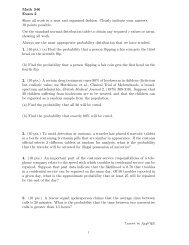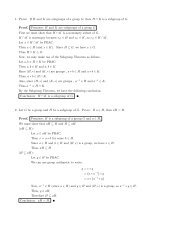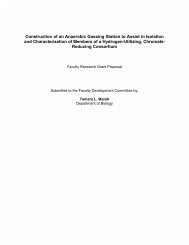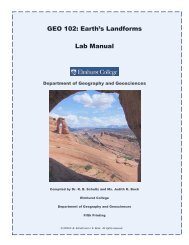Free Executive Summary - Elmhurst College
Free Executive Summary - Elmhurst College
Free Executive Summary - Elmhurst College
You also want an ePaper? Increase the reach of your titles
YUMPU automatically turns print PDFs into web optimized ePapers that Google loves.
Learning to Think Spatially: GIS as a Support System in the K-12 Curriculum<br />
http://www.nap.edu/catalog/11019.html<br />
SPATIAL THINKING IN EVERYDAY LIFE, AT WORK, AND IN SCIENCE 55<br />
information in functional ways. Architects slice space into two-dimensional planes. Air traffic<br />
controllers slice space into two-dimensional layers and time into slices.<br />
Researchers have investigated how air traffic controllers think about space and time in order to<br />
create display systems that conform to the process of spatial thinking (Wickens, 1992, 1998;<br />
Wickens and Mayor, 1997). Air traffic controllers think about space as an ordered stack of twodimensional<br />
layers varying in altitude and can deal with each layer separately, turning a threedimensional<br />
task into a series of two-dimensional tasks. This way of thinking has affected the<br />
design of visual support systems for air traffic controllers and the way in which flows of incoming<br />
and departing aircraft are organized. Aircraft are confined to altitude layers as a function of flight<br />
distance and destination. There are complex interactions between the ways in which the mind<br />
structures a multifaceted problem and the way in which we design cognitive tools and support<br />
systems to facilitate performance.<br />
Earlier, we observed that one hallmark of an experienced architect is the ability to make<br />
behavioral or functional inferences from structural spatial information. This ability characterizes<br />
expertise in other domains as well. Experts at mechanical thinking, for example, can “see” how a<br />
device will behave from its structure (Heiser and Tversky, submitted). They can look at the structure<br />
of a bicycle pump or car brake or pulley system and anticipate its operation, understanding how<br />
parts move and affect each other to produce desired outcomes. Novices or people low in spatial<br />
ability can also understand the structural relations among the parts of a device, but they have<br />
difficulty anticipating its behavior or function. Teaching this spatial thinking skill is part of the<br />
process of turning novices into experts in everyday life, in the workplace, and in science.<br />
3.4 SPATIAL THINKING IN SCIENCE<br />
The effectiveness of nonverbal processes of mental imagery and spatial visualization . . . can<br />
be explained, at least in part, by reference to the following interrelated aspects of such processes:<br />
their private and therefore not socially, conventionally, or institutionally controlled nature; their<br />
richly concrete and isomorphic structure; their engagement of highly developed, innate mechanisms<br />
of spatial intuition; and their direct emotional impact. (Shepard, 1988, p. 174)<br />
Spatial thinking is deeply implicated in the conduct of science. This is not to argue that science<br />
can only be done by means of spatial thinking. It is to argue that many classic discoveries and<br />
everyday procedures of science draw extensively on the processes of spatial thinking.<br />
The <strong>Executive</strong> <strong>Summary</strong> describes the role of spatial thinking in one of the great discoveries<br />
in modern science, Crick and Watson’s double-helix model of the structure of DNA in biochemistry.<br />
Chapter 1 illustrates the role of spatial thinking in epidemiology. Here, the committee<br />
focuses on spatial thinking in astronomy, geoscience, and geography. These sciences have many<br />
things in common. They are Earth-centric. They are empirical sciences that are predominantly<br />
nonexperimental in character, relying on interpretation of hard-won observations of existing situations.<br />
In recent decades, each has experienced floods of data from newly developed observational<br />
technologies: sensors (such as seismographs and high-resolution hydrophones), sampling devices<br />
(such as deep sea and ice core drilling technologies), satellites (including multispectral imagery<br />
and global positioning systems [GPS]), and platforms (such as the Hubble telescope and the Alvin<br />
submersible).<br />
Astronomy, geoscience, and geography have gone from being data impoverished to data enriched,<br />
if not data overwhelmed, placing a premium on the ability to manage and interpret data. At<br />
the same time, each has developed procedures to deal with data problems: generalization to cope<br />
with overspecificity and detail; extrapolation and interpolation to deal with missing data; correction<br />
procedures to deal with error and uncertainty. Because of the inherently spatial nature of their<br />
Copyright © National Academy of Sciences. All rights reserved.












